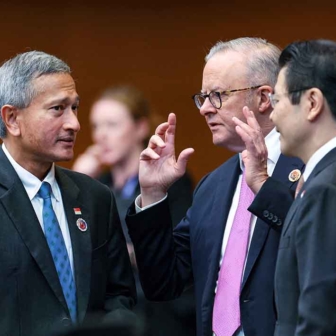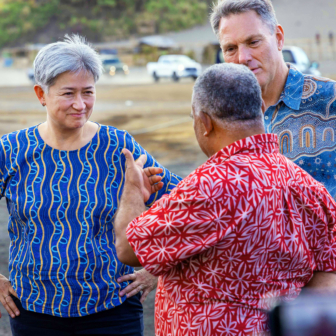Like many other people who live in Mumbai I’ve had afternoon tea at the Taj Mahal Hotel recently, enjoyed a few gin and tonics at the Leopold Cafe and caught trains from Chhatrapati Shivaji Terminus, which is one of India’s busiest railway stations. And like many people here I awoke to the terror attacks in Mumbai on Thursday 27 November and soon became glued to the TV coverage and the breaking news on the websites of English language daily newspapers. Having lived in Mumbai for the past four months, I responded to the threat of violence like many other Mumbaikers and stayed at home rather than going to work. It takes me about twenty minutes, depending on the traffic conditions, to reach the area in South Mumbai in which the terrorist attacks took place. The places attacked are frequented not only by many Mumbaikers for business and social activities, but also by domestic and visitors.
The overall death toll at the moment remains at 172, including twenty-six foreigners, and 248 injured. Nine terrorists were killed and one captured. What is different about this terror attack on India’s most cosmopolitan and modern city is the magnitude, scale and planning of the attacks and the ensuing three-day siege and carnage. During this time the streets in South Mumbai were deserted, malls and restaurants empty, and most wedding ceremonies, pre-wedding functions and other social gatherings were cancelled. Many residents felt like hostages in their own neighbourhood as commandoes patrolled the streets.
While I was not personally affected by the violence, I have friends and colleagues who were. They all tell stories of anxiety and anger, and the hope that something positive can come of such experiences. Terror attacks, though, are not new in Mumbai. On 11 July 2006, seven bomb blasts on suburban trains killed 181 and injured 898 people. On 12 March 1993, a series of thirteen bomb explosions took place, killing more than 257 people and injuring 713.
The first target last week was the Chhatrapati Shivaji Terminus, where 56 people were killed when two of terrorists fired randomly at commuters. Then the Cama Hospital and the Leopold Cafe were targeted. The sieges took place at the Oberai Trident hotel, the Taj Mahal hotel, and at Nariman House. The siege at the historic and iconic Taj Mahal Hotel lasted for sixty hours. These attacks have triggered outrage from ordinary people against a widely perceived apathy and ineptitude by politicians in addressing the security and intelligence problems that allowed this to happen. Politicians are now viewed by many as spending more time and public money on their own security rather than that of citizens.
Three incidents highlight these lapses in security and intelligence. First, the Navy and the Coast Guard allowed the terrorists to land on the shores of Mumbai. The Navy chief of staff, Admiral Sureesh Mehta, has admitted there had been a “systemic failure” on the part of the security and intelligence establishment and that the Navy was not given any prior “actionable” intelligence inputs. Second, the National Security Guard, whose base is at Manesar in Haryana, had to spend an hour travelling to Delhi Airport and then wait another one and half hours before taking off for Mumbai because this paramilitary force does not have its own air wing, despite repeated requests. Third, the Mumbai Fire Brigade, which carried out rescue operations at the Taj Mahal and Oberai Trident hotels, did so without bulletproof vests and other personal safety protection equipment. While the Brihanmumbai Municipal Corporation approved a proposal thirteen months ago to allow the brigade to import such equipment, it is awaiting cost clearance.
The political anger has so far claimed three scalps. The first to go was the home minister, Shivraj Patil. An editorial in the Times of India said that “his ineptitude was evident not just in the rise in terror attacks during his tenure in the home ministry but also in his inability to communicate the government’s will to crack down effectively on terrorism.” He has been replaced by the finance minister, P. Chidambaram.
Public opinion has also forced the Maharashtra state’s chief minister, Vilasrao Deshmukh, and his deputy, the state home minister, Raosaheb Rao Patil, to resign for being perceived as inept administrators and insensitive to the problems facing people in the state. Patil’s insensitivity was highlighted when he uttered (in Hindi) during the sieges that “small incidents like this always happen in big cities.” He will also be remembered for his moral policing, which had closed down bars in Mumbai and put hundreds of dancers out of their jobs, forcing many into prostitution and some, it’s alleged, to commit suicide.
The Congress Party took two days to accept Deshmukh’s resignation as it grappled with the issue of leadership change in the state. It was Desmukh’s visit to the Taj Mahal hotel, with his actor son and a noted Bollywood director – which made the inspection tour of the devastated site almost look like a location scout for a film shoot – that was the final straw for many people.
Along with their anger, city residents have also been battling paranoia, panic and rumours. Sounds like gunfire caused panic last Friday at CST station, resulting in train services being halted or half-an-hour. On day three the Mumbai Police sought the blackout of some cable news channels in South Mumbai in a bid to quell fear and rumours flying across the city. Even several days after the Taj siege ended there were multiple text messages warning of possible attacks on schools and hotels being sent. This prompted the Mumbai police to issue an advisory to the citizens that these were “false” messages and assure them of safety.
There has also been widespread criticism of the electronic media’s coverage of the unfolding events. The competition among the TV channels resulted in breaches of journalist ethics, including an interview by India TV with a terrorist who was reportedly in Nariman House. The detailed and live coverage of the battle between the commandoes and the terrorists over the three days has raised the question of the safety of the hostages and the success of the operation was put at risk. Sources close to the National Security Guard have said that the live footage of commandoes being dropped onto the rooftop of Nariman House on 28 November, not only compromised their safety but also the safety the five hostages inside the building. Later, journalists charged into the newly secured Taj Mahal hotel despite requests from the National Security Guard to stay off the site.
The News Broadcasters Association of India has responded by announcing a meeting this week to consider the development of a self-regulatory code of conduct to be followed in any similar situations in the future. The Information and Broadcasting Ministry in New Delhi has asked TV channels to refrain from repeated broadcasts of the terror attacks.
THE TERROR ATTACKS have raised three questions for me. First, what are the implications for India–Pakistan relations, which have recently shown some signs of improvement? A growing body of evidence suggests that the attack was planned by Lashkar-e-Taiba, a Pakistani-based Islamic terrorist organisation which seeks to drive out Indian security forces from the disputed state of Jammu and Kashmir and is allegedly supported by the Pakistan intelligence agency Inter-Services Intelligence. Laskar-e-Taiba was also implicated in the July 2006 bomb blasts. The political response to date has been restrained.
India’s foreign minister, Pranab Mukherjee, says only that “time will show” what action India will take, and that “every sovereign nation has the right to protect its territorial integrity and take action as it saw fit.” But he cautioned journalists against misinterpreting this to mean taking military action. The prime minister, Manmohan Singh, has asserted that “no coward, no terrorist, no enemy of our secular and democratic republic will ever succeed in destroying the unity of our country.”
Pakistan’s President Asif Ali Zardari has renewed his pledge of no first use of nuclear weapons and has blamed the attack on non-state actors, while implicating his own intelligence agency in past acts of terrorism. Pakistan has offered India a “joint investigating mechanism” to probe the Mumbai attacks, and suggested that the National Security Advisers of both countries jointly head it.
Secondly, can the city maintain its record of not having witnessed a Hindu-Muslim riot for the last fifteen years? Several responses from the Muslim community might help to maintain this record. The Muslim Jama Masjid Trust, which runs the Marine Lines Bada Qabrastan (cemetery), has refused to bury the bodies of the nine terrorists. Normally, unclaimed bodies thought to be Muslims are given to the nearest Muslim graveyard for burial after three days. Several Muslim organisations are planning a silent rally from CST to the Oberai Trident hotel on 8 December on the theme of “killers of innocents are enemies of Islam” and “our motherland’s enemies are our enemies.”
The Hindu right has so far remained silent. But as 6 December is the eighteenth anniversary of the demolition by Hindu fundamentalists of the Babri Masjid at Ayodhya, the police are reviewing all security arrangements in the city.
My third question concerns whether the public anger against politicians can be translated into effective and long term electoral reform in India. While some of my Indian colleagues say that such outpourings have occurred before after terror attacks, I am optimistic that change may be possible, especially viewed against the economic instability that has been introduced into the lives of the young, in particular, and the significance of the election of Barak Obama.
There have been impromptu vigils and peace marches in Mumbai and other major cities, bringing together not only people from across India’s diverse religious and ethnic spectrum but also people from across the often deeper economic and social divide. The mood of anger against politicians has been evident on the posters and banners which have been carried by participants: “Enough of terrorism,” “Politicians get out” and “We want actions not words.” The presence of large numbers of affluent middle-class people at these rallies – people who have long been disaffected by the Indian political process – was significant. As one participant at the 20,000-strong rally in front of the Gateway to India observed, “If the informed and educated don’t lend a voice of unity and strength now who will?” The other significant presence was the many younger people who were largely brought together by email, city-wide text messages and postings on Facebook.
If these outpourings of anger and grief coalesce into a greater involvement in the political process, electoral reform may be possible. Reforms are necessary to address the perceived widespread corruption and lack of accountability of politicians at all levels of government. There is also a need to make all candidates declare any criminal record, to give consideration to holding state and general elections at separate times, and only allowing a candidate to only stand in one constituency rather than multiple ones at present. As there are state assembly elections in Maharashtra and national elections scheduled for April–May 2009, people will soon have the opportunity to express such sentiments. •




